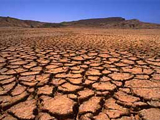Is Water Scarce?
25 Feb 2010
By Denis Burke, Verena Schaer for ISN
Throughout history there have been various struggles over ownership, pollution and scarcity of water resources. But together with the global development crisis, climate change and food insecurity, problems of water management recently experienced a wave of attention.
Any serious discussion about environmental safety, health, pollution, agriculture, land use, supply, distribution and price of food must take the world’s water future into account. In fact, 70 percent of the external pageavailable freshwatercall_made in the planet is used by the agricultural sector and 20 percent by industry. Both activities place growing demand on the resource, and the use of chemicals diminishes its quality. Take for example Asia’s Green Revolution: Relying on intensive irrigation, it increased chemical pollution and also pitted farmer against farmer in a competition for water that was once shared and conserved according to traditional methods.
Water management problems have increased due to growing demand for water resources and concerns about water scarcity in the future. If per capita consumption continues to rise at its current rate, humankind could be using external pageover 90 percent of all available freshwater within 20 yearscall_made.
The rapidly increasing global population will create larger global demand for water, and greater numbers of people will have inadequate water supplies. Growth will mainly happen in urban areas, and since many new cities will be poor, ensuring a external pagesupply of water to these population centerscall_made will be a major challenge. The impact of water usage control measures - including policies that involve water entitlements, taxation and economic incentives - will not be neutral across persons; the cost will fall more heavily on vulnerable and marginal peoples.
Today, more than half of the world’s major rivers are polluted and/or drying up in their lower reaches because of overuse. The external pagehuman consequences of unsustainable watercall_made use are numerous:
- Over one billion of the world’s more than six billion people do not have available sources of clean drinking water.
- An additional 1.6 billion people who have access to water for basic survival do not have sufficient water for health and hygiene.
- Over two million people die every year due to a lack of safe water.
Lack of water is related to low standards of living, bad health and hygiene, poverty and lack of educational opportunities. Global development programs and access to water are not separable concerns. Indeed, water is a basis to achieve the external pageMillennium Development Goalscall_made. Just like the food crisis, the present water crisis is not simply about water but gaping global inequalities. The poor - especially women and children - in developing countries are the most affected by inadequate water supply.
Water politics as source of discordDespite the various water conferences and forums held since the 1970s and the declarations, resolutions and detailed plans of action issued, the world has not been able to solve the water supply and sanitation crisis. On the contrary, a review of the latest headlines reveals misuse of cross-border rivers, growth plans that stoke ecological fears and contaminated water in refugee camps. In short, water politics are a source of discord.
But external pagewater problems differcall_made depending on the region of the world affected. Some regions have water surpluses, while others cannot cover their needs from internal sources. Nine countries hold 60 percent of the world’s water resources (Brazil, Russia, Canada, Indonesia, China, Colombia, the US, Peru, and India.), while others depend significantly on water resources outside their national borders (e.g. Turkmenistan 96%, Egypt 96%, Syria 84%). Because water is not evenly distributed, 33 countries depend on other countries for more than half of their renewable water resources.
There are also enormous external pagediscrepancies in the per capita consumption of watercall_made across the globe, and some populations have access, for geographic and political reasons, to far less than the generally agreed minimum of 500 cubic meters per capital.
The basic problem regarding water resources is that of distribution. Many experts argue that there is no absolute shortage of water at the global level but that its distribution at the regional and local levels is the cause of imbalance. Lack of water is a social problem closely related to political and economic power structures at the global level and can only be addressed by taking these structural dynamics into account.

